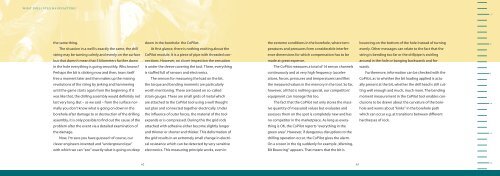BAKER HUGHES
Create successful ePaper yourself
Turn your PDF publications into a flip-book with our unique Google optimized e-Paper software.
W H AT DOE S I N TEQ M A N U FACTUR E ?<br />
– 5<br />
the same thing.<br />
The situation in a well is exactly the same, the drill<br />
string may be turning calmly and evenly on the surface<br />
but that doesn’t mean that 5 kilometers further down<br />
in the hole everything is going smoothly. Who knows?<br />
Perhaps the bit is sticking now and then, tears itself<br />
free a moment later and then makes up the missing<br />
revolutions of the string by jerking and hammering<br />
until the game starts again from the beginning. If it<br />
was like that, the drilling assembly would definitely not<br />
last very long. But – as we said – from the surface normally<br />
you don’t know what is going on down in the<br />
borehole after damage to or destruction of the drilling<br />
assembly, it is only possible to find out the cause of the<br />
problem after the event via a detailed examination of<br />
the damage.<br />
Now, I’m sure you have guessed: of course, our<br />
clever engineers invented and “underground eye”<br />
with which we can “see” exactly what is going on deep<br />
down in the borehole: the CoPilot.<br />
At first glance, there is nothing exciting about the<br />
CoPilot module. It is a piece of pipe with threaded connections.<br />
However, on closer inspection the sensation<br />
is under the sleeve covering the tool. There, everything<br />
is stuffed full of sensors and electronics.<br />
The sensors for measuring the load on the bit,<br />
the torque and bending moments are particularly<br />
worth mentioning. These are based on so-called<br />
strain gauges. These are small grids of metal which<br />
are attached to the CoPilot tool using a well thought<br />
out plan and connected together electrically. Under<br />
the influence of outer forces, the material of the tool<br />
expands or is compressed. During this the grid rods<br />
attached with adhesive either become slightly longer<br />
and thinner or shorter and thicker. This deformation of<br />
the grid results in an extremely small change in electrical<br />
resistance which can be detected by very sensitive<br />
electronics. This measuring principle works, even in<br />
the extreme conditions in the borehole, where temperatures<br />
and pressures form considerable interference<br />
dimensions for which compensation has to be<br />
made at great expense.<br />
The CoPilot measures a total of 14 sensor channels<br />
continuously and at very high frequency (accelerations,<br />
forces, pressures and temperatures) and files<br />
the measured values in the memory in the tool. So far,<br />
however, all that is nothing special, our competitors’<br />
equipment can manage this too.<br />
The fact that the CoPilot not only stores the massive<br />
quantity of measured values but evaluates and<br />
assesses them on the spot is completely new and has<br />
no competitor in the marketplace. As long as everything<br />
is OK, the CoPilot reports “everything in the<br />
green area”. However, if dangerous disruptions to the<br />
drilling operation occur, the CoPilot gives the alarm.<br />
On a screen in the rig suddenly for example „Warning,<br />
Bit Bouncing“ appears. That means that the bit is<br />
bouncing on the bottom of the hole instead of turning<br />
evenly. Other messages can relate to the fact that the<br />
string is bending too far or the drillpipe is swirling<br />
around in the hole or banging backwards and forwards.<br />
Furthermore, information can be checked with the<br />
CoPilot, as to whether the bit loading applied is actually<br />
present at the bit, whether the drill head is still cutting<br />
well enough and much, much more. The bending<br />
moment measurement in the CoPilot tool enables conclusions<br />
to be drawn about the curvature of the borehole<br />
and warns about “kinks” in the borehole path<br />
which can occur e.g. at transitions between different<br />
hardnesses of rock.<br />
0<br />
5<br />
10<br />
15<br />
62<br />
63<br />
20



